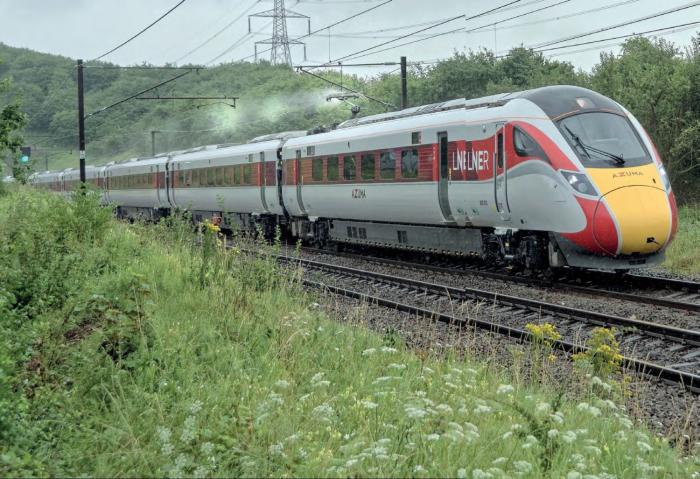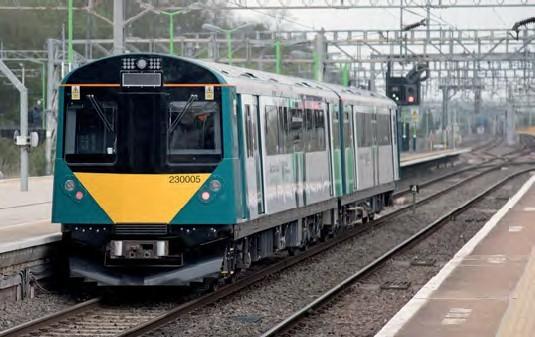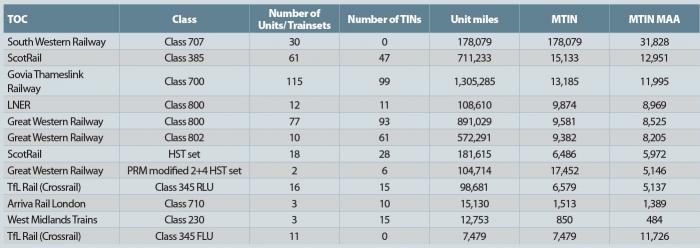Class 230s enter New Train TIN-watch, while Azumas join the battle of the bi-modes

This month we welcome West Midlands Trains’ Vivarail Class 230 diesel multiple-units to the Table of Truth. It’s a pretty inauspicious debut at the bottom of the table.
It was on 8 October 2014 that I met Adrian Shooter at St Pancras International for a chat over coffee about his proposal to re-purpose London Underground D78 stock into low-cost diesel multiple-units. I say chat, but it was more of an interrogation.
My notebook has a list of practical objections written in ball point before the meeting, from crashworthiness to routing of the engine exhausts. All have been ticked off in the pencil I use for note taking.
Now, just under five years later, with some alarms and excursions along the way, the first units are in passenger service; Vivarail has two manufacturing plants; and five diesel-battery hybrid three-car units are being produced for North Wales services.
Talking over the initial performance of the three Marston Vale units with the Vivarail Chief Executive, Adrian Shooter was as candid as ever.
As already mentioned in the previous story, Vivarail was caught out by the combination of very high ambient temperatures and the ability of pollen to clog radiators. Fouling has been resolved with a new air system which allows the radiator matrices to be blown out more frequently.
There have been a number of other issues with the generator set modules, which contain a five-cylinder Ford automotive diesel engine driving an alternator. There have been minor issues with ancillary systems such as turbochargers and emissions equipment. Most have been easily resolved, such as the original multiplex plug for the Engine Control Unit that preferred a permanent relationship with its socket to being disconnected periodically.
‘It’s not as good as it should be’, Mr Shooter concedes, ‘but we’re going to sort it’. Reliability growth will be assisted by the introduction of real-time remote condition modelling, which will supplement the driver’s ‘feel’ for performance if engines lose power.
Meanwhile, Vivarail’s Seaham plant is building the generator sets for the Welsh trains and has also set up a wiring facility.
Vivarail is also developing its own air conditioning system for the Welsh contract. This will feature four standard units that will be easier to change out for servicing, as well as providing redundancy.
AZUMA
We should not be surprised that in the battle of the bi-modes, the LNER fleet of Hitachi Azuma nine-car Class 800s has leap-frogged their more experienced GWR cousins.


For a start, with the withdrawal of the GWR IC125s, all the pressure is on the 800 Series units which have daily diagrams to meet, with no fallback option. On top of that, most of the Azuma mileage is under the wires on the London-Leeds route, in contrast to GWR’s extensive diesel mileage on West of England and Welsh services. As we know, electric traction is inherently more reliable than diesel.
A further boost for LNER is that from the beginning of August nine-car Azumas were cleared for both diesel and electric operation through to Edinburgh. Five-car units have yet to be cleared for service north of Newcastle Central, other than for test running.
I suspect that this is a function of the ‘interlacing’ of traction inverters which is used to reduce electro-magnetic emissions. This is more effective with the five inverters of a nine-car, compared with the three inverters of a five-car unit.
Meanwhile, my apologies for not reporting back on the LNER Class 800/1 experience, despite having had two ‘tasting’ trips as part of the LNER launches. Overall the ride is reminiscent of a Mk 4 coach: very smooth on very good track, but ‘busy’ on less than perfect rail, with a tendency to break up momentarily over switch & crossing work. As someone said on the York demonstration trip ‘you know that you are travelling’, which he saw as a positive feature.
Meanwhile, more new fleets will enter the table next month. The next milestone will be the first new diesel to reach the 10,000 MTIN mark.
NEW TRAIN RELIABILITY, PERIOD 3 2019-20

